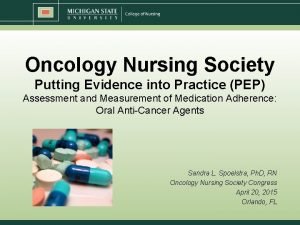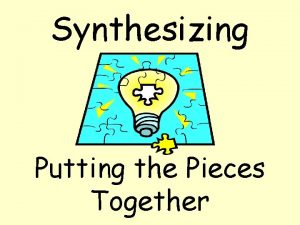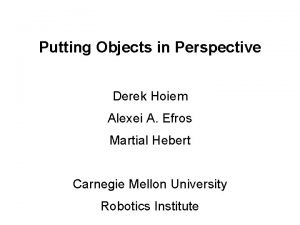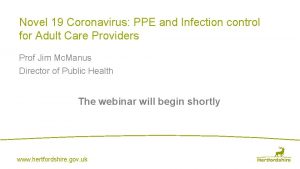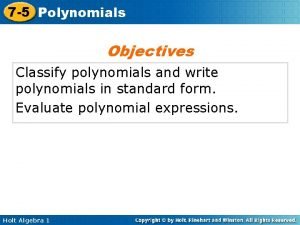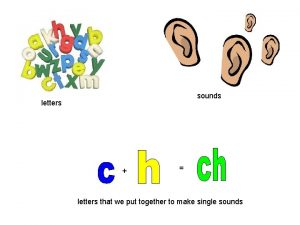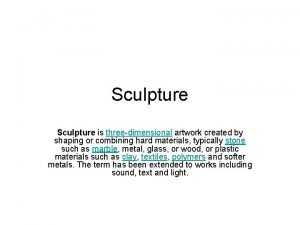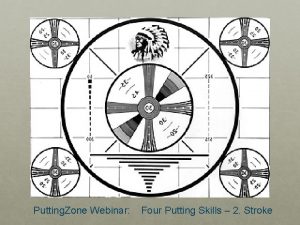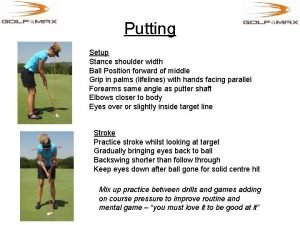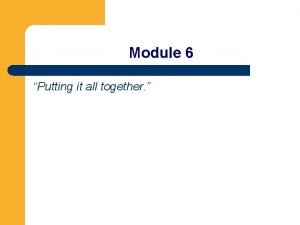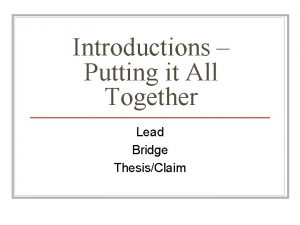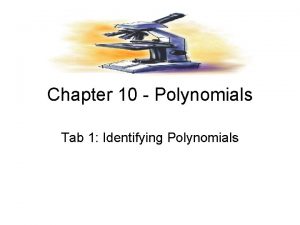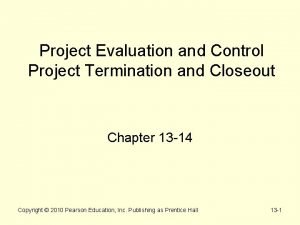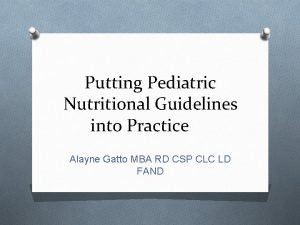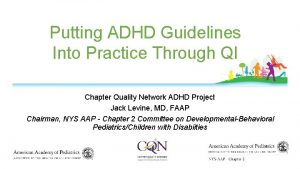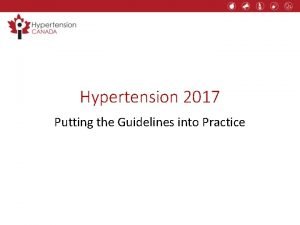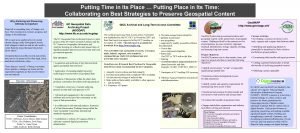Putting Science into the new U K guidelines





















































- Slides: 53

Putting Science into the new U. K. guidelines David Perrett Professor of Bioanalytical Science Barts & the London School of Medicine & Dentistry Queen Mary University of London

v. CJD appeared in 1996 in U. K. Most probably came via consuming abnormal prions in BSE infected beef 230 confirmed cases worldwide (Sept 2015) 177 cases in the UK (all dead) >2050 cases of all forms of CJD since 1990) Prions adhere very strongly to stainless steel and are not removed by standard decontamination and sterilising procedures CJD and v. CJD has been transmitted via surgical instruments and blood transfusions Alzheimer’s disease has also apparently been transmitted (Collinge et al. Nature Sept 2015) © Professor David Perrett

v. CJD One v. CJD carrier in every 2000 appendices analysed to August 2012 DH data BMJ Sept 2013 Infective dose is about 1000 prion molecules These suggest that v. CJD could self perpetuate in the UK © Professor David Perrett

1999 – Dept of Health (England) assembled a Research Group on v. CJD transmission Identified need for research into Present status of decontamination in SSDs Evaluate protein detection Investigate practices in hospitals AND general dentistry Improve instrument design for better cleaning The research spend to date approx. € 25 M © Professor David Perrett

X Decontamination Sterilisation = We must reduce the prion risk However Pr. Psc is very hydrophobic with a remarkable affinity for stainless steel There is no routine sensitive assay for v. CJD in blood or on surgical devices So DH working group concluded that we need to study total protein © Professor David Perrett

Defining the Challenge

Instruments after chopping Brain Tissue (Wet)

The PROBLEM Instrument (n=4) Mass (mg) of Tissue added Kidney (wet) Brain (dry) (wet) (dry) Surgical Blade 5. 7± 2. 4 2. 0± 0. 8 48± 8 12± 1 Forceps 60± 45 8. 6± 13. 4 33± 32 15. 8± 15 Tweezers 12± 6 1. 9± 0. 9 43± 16 14. 3± 5 Mass (µg) of Protein equivalent Blades 1140± 120 2000± 800 Forceps 3000± 2250 3300± 320 Tweezers 600± 300 4300± 16 00

The Problem in Hospitals 2003 DH (England) randomly collected instrument trays ready for operations from 25 English hospitals Residual protein analysis was performed in 5 different laboratory using 5 different methods I used extensive solubilisation in laboratory detergent followed by OPA/thiol fluorescent assay of the desorbed proteins © Professor David Perrett

Total Residual Protein Some Barts data µg/instrument © Professor David Perrett

National Decontamination Survey Quality classification of CSSDs in NHS in England Initial Follow-up NHS Estates Decontamination Report 2001

© Professor David Perrett

So why the failings: If guidelines were being followed?

Protein released from SSD visually clean and QC failed instruments Passed Mean mass on Instrument = 40. 1µg Failed Mean mass on Instrument = 49. 2µg N =20 in each group Visually clean does not mean protein-free

ISO / EU protein test chemistries ISO 15883 -1: 2009 annex C Test methods for the detection and assessment of residual proteinaceous contamination Methods are By swabbing followed by Ninhydrin Biuret as BCA By solubilisation in SDS Followed by OPA/thiol (DMMEA) with spectrophotometric measurement © Professor David Perrett

Off-instrument testing ISO 15883 -1: 2009 part C. 3. 3. 1. 2 requires that about 10 cm 2 of an instrument is swabbed with water wetted swabs for a few minutes prior to testing with recommended chemical tests Swabbing 10 cm 2 in itself is a challenge! Swab with what? For how long? Tend to swab visually dirty area not necessarily protein © Professor David Perrett

Efficiency of removing proteins with Rayon swabs wetted with two different solutions Bovine Serum Albumin (BSA) Water 0. 5% Triton X-100 32 ± 4% 20 ± 3% remaining 61 ± 5% 24 ± 3% remaining Swabbing 10 -15 strokes A water soluble protein Fibrinogen A hydrophobic protein 10 -15 strokes n = 6 We swabbed where we knew we had placed the protein! Nayuni N, et al. (2013) A critical evaluation of ninhydrin as a protein detection method J Hospital Infection 84 97 -102 © Professor David Perrett

Ninhydrin based testing is one “standard” to monitor protein removal in SSD Cost £ 180 per 100 tests © Professor David Perrett

Positive control is not a Protein! © Professor David Perrett

Ninhydrin Test - Different Proteins and Bio-fluids Nayuni N, et al. (2013) A critical evaluation of ninhydrin as a protein detection method J Hospital Infection 84 97 -102 © Professor David Perrett

So we studied other available test chemistries

Commercial test kits for residual proteins available in U. K. Chemistry Mode Trade Name Supplier Sensitivity (µg BSA) Copper binding + BCA complexation BCA Pro-Test-Q Medisafe Clean-Trace protein 3 -M 1 3 – 50 Depending on temperature and time BCA Dye binding Medi-check residual Hygiena protein test Pyrogallol Red Pyromol Test + Molybdate Coomassie Scope Check Brilliant Blue 1 – 10 Depending on temperature and time Pereg Gmb. H 1 Valisafe/Medisafe 1 1 (Bradford Assay) Ninhydrin Denta Check Valisafe/Medisafe Ninhydrin Protein Detection Test Haemostik Browne (Steris) Haemoglobin Bioluminescence ATP na na na Sensitivity taken from manufacturer’ s publications

Bradford (Coomassie) test kit look for protein turning the solution blue - 8 4 2 µg 0. 8 © Professor David Perrett

Validation of AWDs in UK A qualified test engineer applies a test soil to some instruments, then runs a washer cycle and then checks for residual protein Browne’s soil Edinburgh soil Add water to powder, shake vigorously and apply to the test load with a brush 100 ml 10 ml 2 g Dry for 30 min at RT, wash with normal procedures then inspected for residual soil. The soil’s bright red colour allows easy identification of areas not properly cleaned Fresh egg yolk Defibrinated horse blood Dehydrated hog mucin Dry on, wash and then test with… ninhydrin Non-toxic; contains no blood products © Professor David Perrett

U. K. Government’s working group on Decontamination of Reusable Surgical Instruments concluded that the present methods for protein detection on reusable instruments are not fit for purpose. Methods need to be some 100 x more sensitive and detect proteins on the total instrument Realistically this is only possible using fluorescence

Fluorescence Compared to colorimetric measurements is more 1000 x more sensitive is many fold more specific but it needs intense light sources often lasers © Professor David Perrett

In situ protein detection technologies funded by DH (England) in 2010 University. Clinical Centre Chemistry (Technology) Sensitivity Barts QMUL. GOSH and UCHL (London). OPA/NAC (CCD imaging) Detection at levels <50 ng/ml. University of Southampton General Hospital. SYPRO- Ruby 10 pg/mm 2 for Thioflavin, total protein. (EDIC/EF) 400 pg/mm 2 for amyloid. University of Edinburgh. Royal Infirmary Edinburgh FITC (EFSCAN). 100 attomoles/ mm 2. OPA/NAC = o-phthalaldehyde / N-acetyl – L-cysteine; EDIC/EF = episcopic differential interference contrast / Epifluorescence; EFSCAN = fluorescence scanning of FITC fluorescein Isothiocyanate Notes. Dual scan with amyloid specific stain.

My system combines OPA/N-Acetyl-cysteine a fluorescent reagent with CCD visualisation with 2 -D & 3 -D quantitation to detect residual proteins in situ 2011 Concept and design patented by my university (QMUL) 2012 A licence was granted to Synoptics Cambridge UK © Professor David Perrett

OPA/NAC Reagent for Proteins Fluorescence ex 350 nm Em 450 nm © Professor David Perrett

Pro. Reveal - 2015

Typical BSA protein standard calibrant Net Volume (RFU) 35000000 R 2 = 0. 9979 30000000 25000000 20000000 15000000 10000000 5000000 0 0 2 4 6 8 BSA (µg) 8 µg 4 µg 2 µg 1 µg 0. 5 µg 0. 25 µg 0. 125 µg Lo. D (Sensitivity) 50 ng/spot © Professor David Perrett

Typical Pro. Reveal Image Total protein /side = 5. 3µg pg/mm 2 = 30. 3 pg

Reproducibility of Pro. Reveal Same pair of washed then sprayed scissors repeatedly placed in system and imaged Partially open (n=8) Mean SD CV 26. 11 0. 90 3. 45% Fully open (n=6) 21. 85 0. 55 2. 54%

Typical results using brain spotted SS tags with alkaline wash in an AWD BAKED - post wash Brain spotted SS tags - pre-wash 48 H AIR DRIED - post wash

Quantitative Data

Studies on allowing post- operation drying ALKALINE (Dry) ENZYMATIC (Dry) ALKALINE (Moist) ENZYMATIC (Moist) © Professor David Perrett

Titanium Eye Set Washed in outsourced SSD using detergent X Total Protein shown = 158 µg Washed in SSD C using enzymatic detergent Total Protein shown = 0. 8 µg © Professor David Perrett

Setting limits Eye set (dry µg/side) © Professor David Perrett

Optimisation of Automatic Washer Study © Professor David Perrett

Vali. Pro Tag Cleaned, polished 316 L stainless steel tag Size of standard microscope slide i. e. 26 x 76 mm Accurately pipetted 80 µL spots of 10% brain homogenate in PBS (equivalent 40 µg protein or 1 µg/mm 2) Proteins annealed to the SS at 75 o. C for 1 hour Q. C. tested The system is designed so that a wash in RO water in a laboratory sonic bath removes about 50% of the annealed protein © Professor David Perrett

Methods 3000 tags were washed using alkaline, enzymatic, neutral detergents and water in a specially modified Getinge AWD Many combinations of conditions e. g. temperature, time, detergent concentration, dictated by a Design of Experiments programme Following washing residual protein on each tag was quantified using Pro. Reveal Results were re-analysed in the Do. E package to generate optimal washing conditions Optimal conditions were then applied to 240 contaminated instruments

Summary of washing efficiency Data is mean ± SD for a whole group (n = 60 instruments) in each study % residual protein Water alone 1. 14 ± 2. 8 Alkali 0. 63 ± 0. 6 Non-ionic detergent 0. 44 ± 0. 88 Enzyme 0. 44 ± 0. 48

Randomly chosen images of optimally washed instruments Water washed forceps 4 A Non-ionic washed forceps 8 A Alkali washed forceps 4 A Enzyme washed forceps 17 A

Tri-Lab study The three centres (St Barts / Edinburgh & Southampton University. Test specimens • Reusable Instruments decontaminated under controlled conditions. • Instruments decontaminated by SSDs thought to be compliant with current CFPP guidance. • Single-use instruments not subject to decontamination procedures. 44

0 1 4 7 10 13 16 19 22 25 28 31 34 37 40 43 46 49 52 55 58 61 64 67 70 73 76 79 82 85 88 91 94 97 100 103 106 109 112 115 118 121 124 127 130 133 136 139 142 145 148 µg protein /side Total Residual Protein on 150 instruments from 6 hospitals 70 60 50 40 30 20 10

Main Findings • All three groups/technologies gave similar results • Data for similar instrument types submitted by each group, then a normal (Gaussian) distribution of residual protein was apparent • London and Edinburgh found residual protein that 1020% instruments had unacceptable high levels • Such statistical sound results mean that further calculations are possible

Implications for SSD use? • Sampling procedures? – essentially instrument of a common type drawn from sets • Trend analysis? – we can exert downward pressure on protein levels? • Use of RAG tests etc. – relatively easy to establish at local level but national standards may be difficult • Care needed on operational risk control (e. g. keeping instruments in sets) • At present instruments subject to re-washing after testing • Use of soil testing can be avoided

Some basic facts • Some 1000µg of protein are on a dirty instrument • 1 ng of residual contamination may carry 103 infectious units (Weissman assays) • Infection requires about 103 prion proteins • Validated steam sterilization gives a reduction factor of ca. 103 (Fernie Edinburgh) • 1 in 2000 people are v. CJD carriers • New technologies can detect <50 ng of residual protein • So what residual protein contamination levels will give meaningful risk reduction? Working Party set this challenge to epideminologists Dr Nigel Tomlinson (DH) and Dr Andre Challet (PHE)

The science outlined here today along with the Tomlinson/Challet calculations has informed a significant updating of UK guidelines The Advisory Committee on Dangerous Pathogens (ACDP), an official DH of Health body, issued new guidance in May 2015

ANNEX C of ACDP guidance 2015 GENERAL PRINCIPLES OF DECONTAMINATION AND WASTE DISPOSAL provides information on the general principles of decontamination and waste disposal for transmissible spongiform encephalopathies (TSEs) www. gov. uk/government/uploads/system/uploads/attachment_dat a/file/427855/Annex_C_v 3. 0. pdf

So how clean is clean? • • Maximum residual protein - 5µg total per instrument side Units are BSA equivalent Lower limits needed for neurosurgical instruments SSDs can develop their own QC for each AWD based on a cohort of some 20 instruments tested at least weekly • • Time post-operation should not exceed 1 hour Using new technologies for residual protein quantitation is encouraged Now they have to be adopted in SSDs. Instructional guidance updating CFPP 0101 & HTM 2030 will be published in spring 2016

Summary • New protein detection tests make progress possible • SSDs can routinely produce very clean instruments • Uncertainties over removal characteristics of the Pr. Psc molecule remain • General upper limit of 5µg per instrument side is likely to give meaningful risk reduction

Thanks to The late Prof Don Jeffries (Chair of DH Decon Group) All members of the DH Decon Working Group The teams at the various SSDs we’ve worked with Alasdir at Synoptic Health for his programming DH for funding all this Thanks to you for listening
 Physical rate fences example
Physical rate fences example Putting evidence into practice
Putting evidence into practice Putting the enterprise into the enterprise system
Putting the enterprise into the enterprise system Putting the enterprise into the enterprise system
Putting the enterprise into the enterprise system Putting it into practice
Putting it into practice Putting prevention into practice
Putting prevention into practice Coherent curriculum
Coherent curriculum Putting on the new man
Putting on the new man Math is my favourite subject
Math is my favourite subject Star framework
Star framework Putting-out system
Putting-out system What is nasreen putting chocolate on
What is nasreen putting chocolate on Long term impacts of the industrial revolution
Long term impacts of the industrial revolution Proletarianization ap euro
Proletarianization ap euro Putting the puzzle together main idea
Putting the puzzle together main idea Putting objects in perspective
Putting objects in perspective The order of putting on ppe
The order of putting on ppe Putting it all together motion answer key
Putting it all together motion answer key Fractions in increasing order
Fractions in increasing order Putting people first 2007
Putting people first 2007 Putting-out system
Putting-out system Classification of polynomials
Classification of polynomials Letters put together
Letters put together A 3-d work of art created by shaping or combining materials
A 3-d work of art created by shaping or combining materials Putting zone
Putting zone Put to death the old man
Put to death the old man Putter stance setup
Putter stance setup Putting a package together
Putting a package together Strategic organization helps speeches be more effective
Strategic organization helps speeches be more effective Practice notebook - putting it all together
Practice notebook - putting it all together Putting two words together
Putting two words together Introduction bridge examples
Introduction bridge examples Putting it all together
Putting it all together Project evaluation and control
Project evaluation and control Putting the pieces together case study answer key
Putting the pieces together case study answer key Putting things together is called
Putting things together is called Hình ảnh bộ gõ cơ thể búng tay
Hình ảnh bộ gõ cơ thể búng tay Lp html
Lp html Bổ thể
Bổ thể Tỉ lệ cơ thể trẻ em
Tỉ lệ cơ thể trẻ em Voi kéo gỗ như thế nào
Voi kéo gỗ như thế nào Tư thế worm breton
Tư thế worm breton Hát lên người ơi alleluia
Hát lên người ơi alleluia Các môn thể thao bắt đầu bằng tiếng chạy
Các môn thể thao bắt đầu bằng tiếng chạy Thế nào là hệ số cao nhất
Thế nào là hệ số cao nhất Các châu lục và đại dương trên thế giới
Các châu lục và đại dương trên thế giới Công thức tiính động năng
Công thức tiính động năng Trời xanh đây là của chúng ta thể thơ
Trời xanh đây là của chúng ta thể thơ Mật thư tọa độ 5x5
Mật thư tọa độ 5x5 Làm thế nào để 102-1=99
Làm thế nào để 102-1=99 độ dài liên kết
độ dài liên kết Các châu lục và đại dương trên thế giới
Các châu lục và đại dương trên thế giới Thể thơ truyền thống
Thể thơ truyền thống Quá trình desamine hóa có thể tạo ra
Quá trình desamine hóa có thể tạo ra

